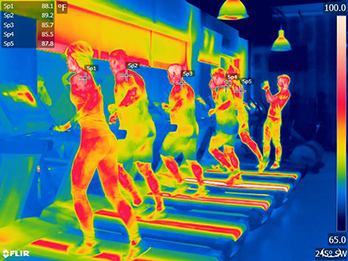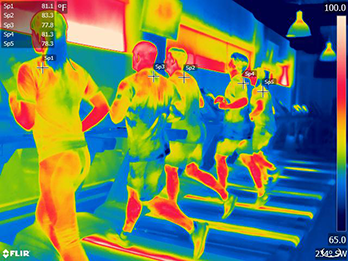The science of feeling cool
The problem
When exposed to heat, the body begins to thermoregulate trying to bring the core temperature back to equilibrium.
We do so by increasing blood flow to the skin and sweat production.
When performing physical labour, rather than having the blood flow to the skin to give off excess heat, it is directed towards the muscles as they require an increased level of oxygen. Without it, the body will build up lactic acid, causing a painful burning sensation. The resulting decrease in blood flow to the skin will ultimately lead to the body storing more heat.
Without the ability to cool down, the body will continue to store heat, thereby raising the internal temperature. The most recognized effect is loss of concentration and inability to focus on a task.
NASA's heat stress report CR-1205 (1) found that temperatures over 80°F have a marked NEGATIVE effect on both the productivity and accuracy of work. At 95°F the report showed that study participants were found to make 60 mistakes / hour. That's 1 mistake every minute.
How heat affects performance
| Effective temperature | Loss in output | Loss in accuracy |
|---|---|---|
| 75° F | 3% | Negligible |
| 80° F | 8% | 5% |
| 85° F | 18% | 40% |
| 90° F | 29% | 300% |
| 95° F | 45% | 700% |
| 100° F | 62% | >> |
| 105° F | 79% | ->> |
The ActiCool solution
Thermal imaging
When we designed ActiCool, we spent a lot time in R&D working with multiple labs to make sure that what we were building was going to work.
We started off with thermal imaging, seeing exactly how the fabrics cool the surface temperature of the skin in various environments and at different levels of strenuous activities. We also performed testing on our users, taking their temperature and heart rate, and monitoring their required amount of hydration.


QMax testing
Then we got really scientific.
We turned to QMax testing, a method of testing the instantaneous feeling of warmth or coolness of an object that encounters the skin.
Basically, how our ActiCool fabrics feel against the skin on contact. The higher the value, the cooler the item feels.
How ActiCool feels against the skin (W/cm2)
Thermal effusivity
Then we moved on to thermal effusivity testing. Thermal effusivity is most typically measured to predict how cool or warm a textile feels.
It has a square root proportionality to the density, thermal conductivity, and specific heat capacity of the material. Dry fabrics often contain pockets of air between the strands, resulting in thermal effusivity values that are typically low. When dry fabrics are exposed to moisture, the air is replaced by water, which has a much higher thermal effusivity. This will cause the fabric to exhibit a higher thermal effusivity value when wet, making it feel cooler.
That is the reason why we moved over to thermal effusivity testing, as it is based on the fact that we are always sweating, and that ActiCool begins to absorb the moisture and humidity from your skin on contact. As we move around and heat up, we sweat more, so we tested our gear at all levels of anticipated physical output.
Effusivity vs moisture
- ActiCool
- Athletic wear
- Expected working range

